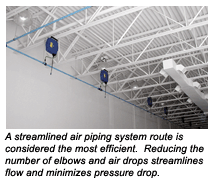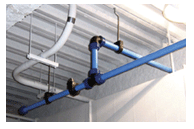As a shop owner or manager, you know the challenge of maintaining profit while facing ever-increasing costs. What you may not know is you can cut your compressed air costs substantially by updating your air piping system.
Generating and maintaining compressed air is typically a shop’s second largest energy expense. A new, efficient air piping system can pay for itself in less than two years. A good system also resists corrosion, scale and other debris that damages and reduces the life of components and pneumatic tools.
The Compressed Air Highway
Think of an air piping system as a highway for air. A highway system and an air piping system both need enough lanes (or pipe diameter) and a streamlined route to be most efficient. Just as a highway system that loops around a metro area is usually the most efficient, a closed-looped ring main or header is most efficient for compressed air.
An air system with many increases and decreases in diameter, like threaded pipe joints, slow air flow like a road full of potholes or lane closures slows traffic flow. Contamination and condensation in air piping are like road debris and water, slowing the flow. Reducing the number of elbows and air drops, much like reducing the number of sharp turns and off ramps on a highway, streamlines flow and minimizes pressure drop.
Road Map To Optimize Your System
Here are some tips to help optimize your compressed air “highway system”:
Material — Four materials are most often used for compressed air piping: black iron, copper, plastic and aluminum. Here are the pros and cons of each.
 Black iron pipe is the cheapest material, but it’s also the most expensive over the life of the shop. Installation and repair labor are costly. Leaks due to internal corrosion can begin as quickly as six months after installation, increasing energy consumption.
Black iron pipe is the cheapest material, but it’s also the most expensive over the life of the shop. Installation and repair labor are costly. Leaks due to internal corrosion can begin as quickly as six months after installation, increasing energy consumption.
Copper pipe has excellent resistance to corrosion. It’s more cost-effective to run, since the smooth inside surface has a lower friction coefficient and demands less work from the compressor to supply the same air volume and pressure. The drawback is that copper is very costly, requires an open flame, skilled labor and more labor hours to install than any alternative.
Plastic pipe is being used less and less. Poorly designed systems have literally exploded — an obvious safety hazard. Some compressor lubricants can deteriorate pipe glue and cause joint failure. The Plastic Pipe Institute (PPI) recommends against using PVC in compressed air systems.
Aluminum pipe has gained huge popularity over the last decade. Aluminum offers excellent resistance to corrosion, lower air friction and is easy to install with no open flame, threading machines or special tools. Aluminum can be installed by shop staff, and can be easily dismantled and moved to another location.
Designing Your System
Be sure your piping system is properly sized to supply your anticipated air volume demand during peak operation, including possible future shop expansion. Here are some tips for a safe, efficient system design:
 Sizing — Properly size all piping components from the ring main to each drop. A looped ring main with a minimum number of elbows (especially around obstacles like support columns) is the most efficient system. This can cut your pressure drops in half while providing built-in storage for your compressed air. Be sure the pipe is installed with adequate supports to ensure optimum efficiency and safety.
Sizing — Properly size all piping components from the ring main to each drop. A looped ring main with a minimum number of elbows (especially around obstacles like support columns) is the most efficient system. This can cut your pressure drops in half while providing built-in storage for your compressed air. Be sure the pipe is installed with adequate supports to ensure optimum efficiency and safety.
Air Treatment — Don’t skimp on air treatment components like condensate control, filtration, lubrication, drains and pressure regulation.
Air Connections — Often overlooked, connections can dramatically affect safety and productivity, and reduce utility costs from leaks. Here are some tips to help you choose safe and efficient air components for your shop:
Quick couplings — Specify “venting-action” safety quick couplers at the air source or manifold. This simple choice eliminates “hose whip” reducing personal injuries and damage to equipment or vehicles. “Hose whip” occurs when disconnecting a pressurized air hose. Impact-resistant composite quick couplings with a quick push-button release can make one-handed disconnection easier than a conventional sleeve.
Hose assemblies — In areas where there’s a lot of traffic or activity, select self-coiling hoses or retracting hose reels to keep air hoses out from under foot and provide a safe, efficient work area.
Blow guns — Although a minor area, specially designed ergonomic blowguns can operate at full pressure while still being safe and “OSHA-compliant.”
Selecting “bubble tight” or “leak-free” compressed air products is important. One leaky coupler can cost hundreds of dollars in utility costs each year. Multiply that by the number of connections in your shop, and you can see how investing a little more up front can pay huge returns in the long run. So, don’t overlook your compressed air system as a way to reduce costs and improve your profitability.
Is your “highway” optimized, using the best products and materials and giving you the best return on your investment? Or, is it a bumpy old “toll road” that costs you money in constant repairs?
I’ll choose the smooth road over the bumpy one every time.
Mark McKean is the national sales manager for the Prevost Corporation.
